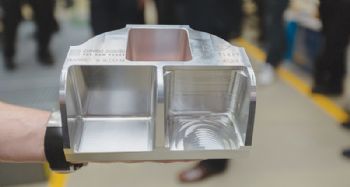
The worlds of CAM and tooling have combined to deliver significant cycle-time savings across a wide range of machining applications, including mould-and-die, turbine blades, impeller blades and blisks.
Combining Open Mind’s (
www.openmind-tech.com) HyperMill Maxx tangent-plane machining strategy with ‘circular-segment’ cutters (barrel milling cutters) from Sheffield-based WNT (UK) Ltd (
www.wnt.com), milling cycle times can be cut by as much as 90% when semi-finish and finish milling on five-axis simultaneous machining centres.
Further benefits include reduced loads on the machine spindle and improved surface quality.
Open Mind’s tangent plane machining strategy was developed with circular-segment cutters in mind. The large radii ground on these cutters (up to 3,000mm) allow much greater step-overs between cutter paths to deliver reduced cycle times.
However, the cutters have to be moved simultaneously in five axes in a sweeping pendulum-like motion over the workpiece.
The HyperMill Maxx user interface simplifies these complex movements, making them easy to program, and maximises the cutter geometry to present the cutter at the optimum orientation to the workpiece at any point on the cutter path.
The benefits resulting from this combination of CAM software and WNT tooling include: increased step-overs while generating the same theoretical scallop height; improved cutting performance in difficult-to-reach areas of a component; significantly greater machining efficiency; reliable finishing strategies and process security; and reduced thermal deformation.
Moreover, fewer tools are required. There are four types of cutter in WNT’s range of circular-segment cutters — barrel shape, oval form, taper form and lens shape.
The key feature of these end mills is the large radii in the cutting area, simulating a ball-nose cutter with a cutting diameter between 12 and 3,000mm and allowing large step-over distances to be used.
With a typical ball-nose cutter, the step-over distance (or axial depth of cut) would be 0.5mm, and the surface finish would be about 1.22µm Ra.
With a circular-segment cutter, this step-over can increase to 1.5mm, and the surface finish can be improved to 0.46µm Ra.
Typical cutting data for a 6mm-diameter circular-segment cutter with three flutes machining tool steel (1.2312) is 300mm/min surface speed, 16m/min feed rate, an axial depth of cut of 1.5mm, and a radial depth of cut of 0.2mm.
Circular-segment cutters can also machine hard-to-reach planes, such as deep pockets in an airframe — and the same cutter can be used to blend the corner radius in a pocket.
WNT and Open Mind have also worked together on a machining strategy known as helical drilling. Making use of standard solid- carbide end mills (or indexable-insert face mills) and the complex motion available from simultaneous five-axis machining centres, it is possible to produce deep cavities from solid material in a very short space of time.
The cutter is presented to the workpiece at a ‘tilt angle’ to avoid machining with the end face, thereby eliminating any issue with the lack of surface speed at the centre of the cutter and reducing the time required to produce a hole by 20-25%.
Furthermore, this use of Open Mind’s software means that only a single cutter is required to produce a variety of hole sizes and shapes — and swarf removal is particularly efficient.
When the Aylesbury-based sub-contractor CNF Precision Engineering installed a five-axis 32-pallet Matsuura MAM72-35V and a five-axis Matsuura MX520, it also bought Open Mind’s HyperMill CAM software.
This combination allowed CNF to make changes to its machining strategies and move away from indexable cutting tools to using solid-carbide end mills — supplied by Tamworth-based Industrial Tooling Corporation Ltd (
www.itc-ltd.co.uk) — for many of its milling processes.
Certified to ISO 9001 and AS 9100, CNF specialises in the medium- to high-volume production of machined parts for
the aerospace, medical, automotive, scientific and defence industries; its output exceeds 6,000 milled components a month.
It is widely recognised that five-axis CAM strategies such as trochoidal, 3-D and tangent-plane milling increase material removal rates by using the full flute length of the cutting tool and increased step-over rates.
CNF is using a number of these high-volume material removal practices to improve productivity, reduce tool wear and enhance surface finishes.
Indeed, since using CAM strategies offered by Open Mind software, it has reduced roughing cycle times by over 80%, with overall cycle times when machining steel cut by 40-50%.
Production manager Mark Baron said: “We used to rough-machine profiles with a 20mm-diameter indexable tool at a feed rate of 800mm/min with a step-over of 1-2%.
"With new machining strategies, we can use the ITC solid-carbide end mills at feed rates of 4-6m/min with depths of cut up to 80mm.
"On steel, we are running ITC solid-carbide tools four-times faster than we used to run indexable tools — and the material removal volume is far higher, because we are using much greater step-over rates.
"What we didn’t expect with higher material removal rates was better tool life and less stress on the spindle, but that’s exactly what the combination of ITC tools and HyperMill CAM software is delivering.
“The tool life on the ITC end mills has always been impressive, but since applying these new machining strategies, the improvement has been significant.
"There are some ITC tools for machining aluminium that were installed in our latest Matsuura MAM72-35V 18 months ago; and despite being used on a daily basis, they still haven’t been changed.
"Most of the end mills for steel machining are lasting three to nine months — which is impressive for a facility that runs 24/7.”